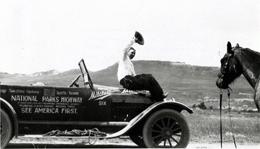On June 4, 1916, the National Parks Highway Association tour sets forth on a 33-day, 3,100-mile automobile journey from Chicago to Puget Sound. It is one of the most important of several such tours between 1912 and 1916 undertaken to demonstrate the feasibility of automobile travel, to promote tourism and commerce, and to advocate for the improvement of roads and highways. The tour instigator and leader is Frank W. Guilbert (d. 1940) of Spokane, an officer in the Good Roads Association of Spokane County, as well as the National Parks Highway Association. The tour will encounter severe weather and horrendous driving conditions, but will manage to reach its destination and document a route that will later become much of Interstate 90 and Interstate 94 across the northern tier of the United States.
Boosting Roads to Parks
In late May 1916, boosters from the National Parks Highway Association, mainly civic and business leaders from Western and Midwestern communities, assembled at the La Salle Hotel in Chicago to hear speeches on road improvement and view hand-colored lantern slides of the scenic wonders of the Northwest. Many of the slides had been taken by Frank Guilbert himself, although some were the work of renowned photographer Asahel Curtis (1874-1941), whose studio did much of the coloring.
The expedition got underway with considerable fanfare on the morning of June 4 in two Mitchell Six automobiles provided by the Mitchell Company of Racine, Wisconsin. In addition to Guilbert, the participants who actually completed the tour were Lawrence H. Brown, a Spokane attorney and director of the sponsoring association, Frank R. Singleton of the Seattle Automobile Club, and James Hoag, a Mitchell Company driver and mechanic.
Others began the tour but did not complete it. One such was Charles C. Hart, a Spokesman-Review reporter who traveled as far as Butte, Montana. Hart's articles chronicling the tour appeared in newspapers throughout the nation, as well as his hometown paper. Another early participant was Thaddeus S. Lane, then president of the Inland Automobile Association. Guilbert served as official photographer for the expedition.
A Patchwork of Roads
The National Parks Highway was not an actual highway, but rather a patchwork of existing roads supposedly maintained by counties or townships. The route designated by Guilbert and his colleagues went from Chicago to Milwaukee, then across Minnesota, North Dakota, Montana, the Idaho panhandle and finally across Washington, by way of Spokane and Snoqualmie Pass. The complete National Parks Highway was envisioned as continuing south over the Pacific Highway from Seattle to Crater Lake. Although the route did not actually lead through Yellowstone, Glacier, and Mt. Rainier national parks, it would get automobile tourists within striking distance.
The Mitchell autos performed well and did not need the extra tires, parts, and even spare motors that had been placed in advance along the route. However, they frequently bogged down in axle-deep "gumbo" produced by the rainiest June in decades. At times, ignominiously enough, horses had to haul them out of the mire. The section along the Yellowstone River was flooded, and even the drier stretches of road were in far worse condition than anticipated. Much improvement would be needed before the National Parks Highway could be recommended unreservedly for tourist travel.
Receptions and Lantern Slides
It was typical for automobile travelers of the day to camp along the roadside, but Guilbert's tour group stayed in hotels, such as they were, along the route. At almost every stopover, the road enthusiasts entertained the dignitaries and townsfolk with their lantern slides. Often their arrival was delayed by bad road and weather conditions, and it was late before they fell into bed exhausted. Early each morning, the two Mitchells and their occupants would set off on the next stage, usually accompanied by a convoy of local motorists.
Heavy snowfalls had kept Snoqualmie Pass closed until July 3, but it was cleared in time for the party to pass between 10-foot banks of snow to meet its projected arrival date in Seattle. A large convoy of automobile enthusiasts, state officials, and dignitaries from Seattle and Mt. Rainier National Park greeted the Mitchells at the summit. Before proceeding to Seattle, this distinguished group held a dedication ceremony for the National Parks Highway. The tour reached Seattle on July 6, 1916, and the attendance at that evening's slide show was 3,000, the largest crowd of the trip.
The tour officially ended on July 7 in Tacoma, where the speedometers of the Mitchells registered 3,100 miles. The Tacoma Daily News of Saturday, July 8, reports, as the culminating event, a trip up to Mt. Rainier National Park sponsored by the Commercial Club of Tacoma, involving 52 automobiles and 300 Tacomans. Frank Guilbert, Lawrence Brown, and others were guests of the Tacoma club.
The aims of the 1916 tour were not realized until after the end of World War I, when finally more Americans were able to take to the roads as tourists. To assist them, the National Parks Highway Association published maps and guides covering road conditions, tourist facilities, garages, and the like.
Good Roads Man
At the time and for decades thereafter, Frank Guilbert was tireless in his zeal for good roads, particularly in Eastern Washington. Through the Spokane County Good Roads Association and the Eastern Washington Highway Association, he lobbied in Olympia for state funding of road improvement, winning millions of dollars for state highways.
As head of the Inland Automobile Association (later AAA) in Spokane, he worked for increased tourist facilities, road maps, standardized traffic laws and signs, emergency services for motorists, and legislation promoting road safety. His camera was constantly useful in documenting both needs and progress. Sometimes it was the means of proving poor workmanship and gaining restitution. During his long career, Frank Guilbert more than earned the sobriquet "the good roads man."

